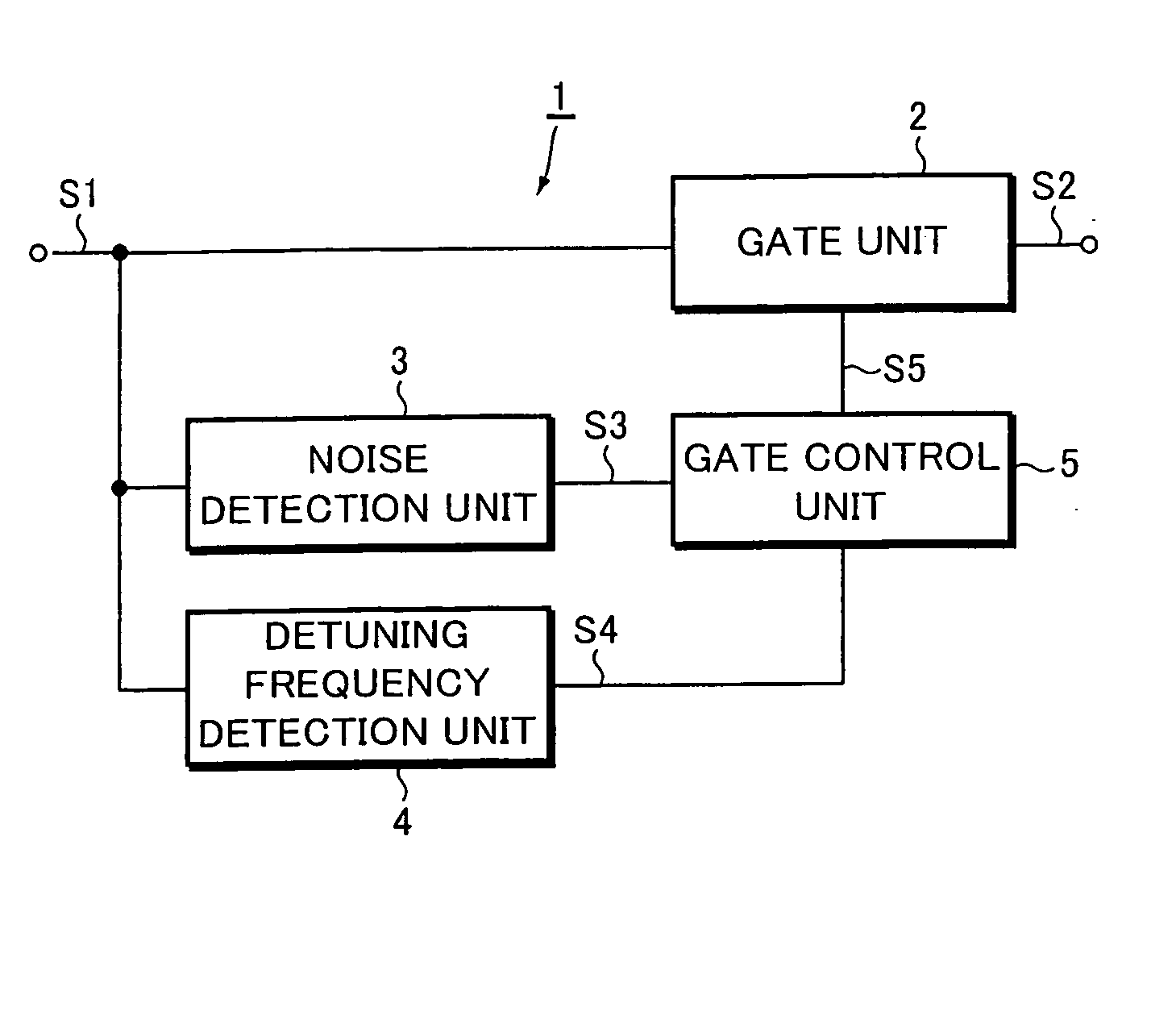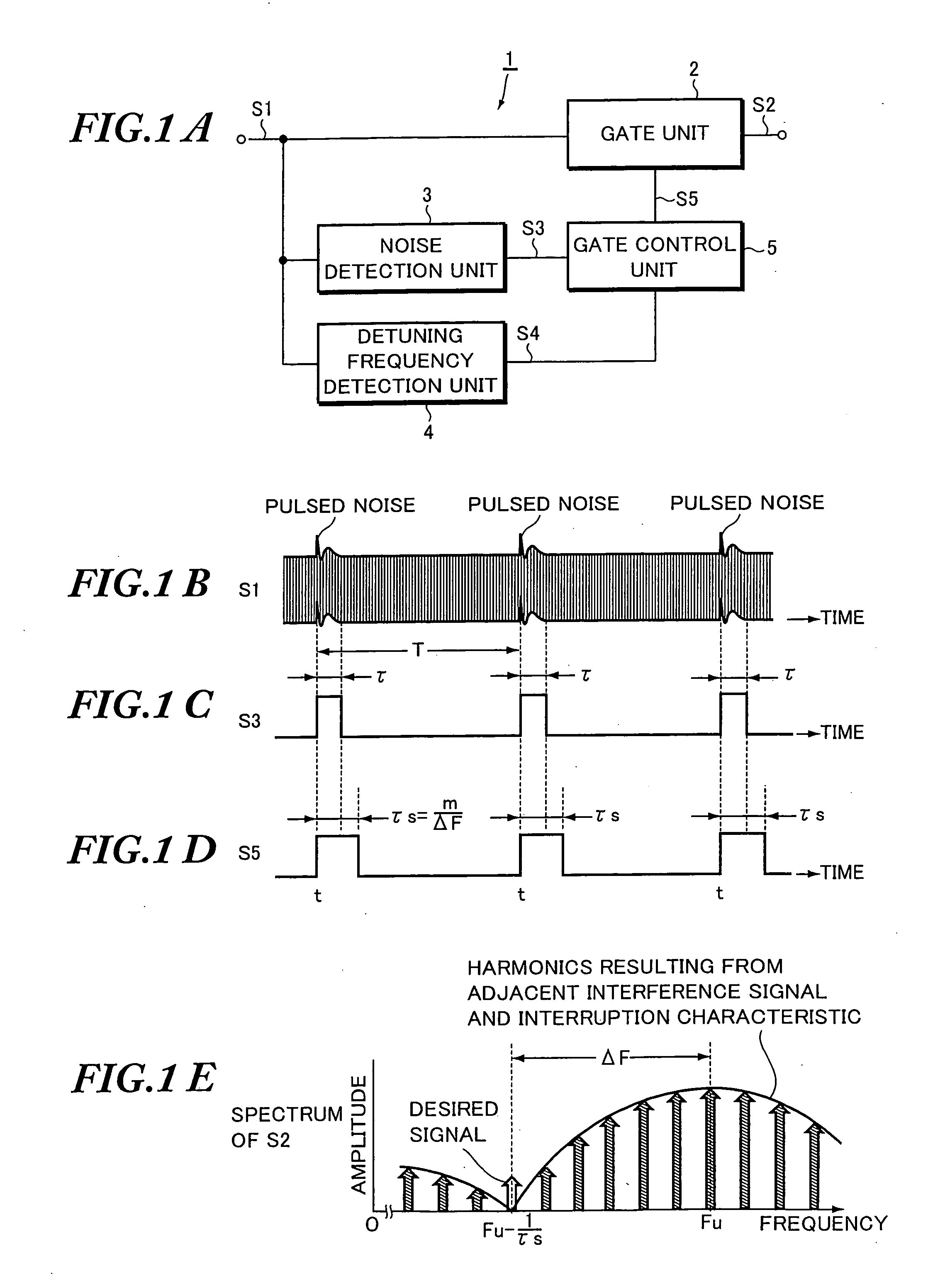Noise eliminator
a technology of noise elimination and filter, which is applied in the direction of gain control, transmission, radio transmission, etc., can solve the problems of deteriorating the selectivity of the desired signal in the filter, harmonic distortion, etc., and achieves the elimination of pulsed noise mixed, reduced effect, and high reliability
- Summary
- Abstract
- Description
- Claims
- Application Information
AI Technical Summary
Benefits of technology
Problems solved by technology
Method used
Image
Examples
example 1
PRACTICAL EXAMPLE 1
[0050] Next, a more specific practical example of the foregoing embodiment will be described with reference to FIGS. 2 to 3G. FIG. 2 is a block diagram showing the configuration of a receiver which is provided with the noise eliminator of this practical example. FIGS. 3A to 3G are waveform charts for explaining the operation of the noise eliminator. In FIG. 2, parts identical or equivalent to those of FIG. 1A are designated by the same reference numerals.
[0051] Initially, the configuration of the receiver will be overviewed with reference to FIG. 2. An RF multiplier 8 is connected to the output of an RF amplifier 6 which is connected with a reception antenna ANT. Then, the RF multiplier 8 mixes an RF signal output from the RF amplifier 6 and a local oscillation signal output from a local oscillator 7 to output a frequency-converted IF signal S1.
[0052] An IF filter 10, an IF amplifier 11, and a detector 12 are connected in series with the output of a gate circuit...
example 2
PRACTICAL EXAMPLE 2
[0083] Next, the noise eliminator 1 according to a second practical example will be described with reference to FIGS. 4 to 5C. FIG. 4 is a block diagram showing the configuration of a receiver which is provided with the noise eliminator of this practical example. FIGS. 5A to 5C are waveform charts for explaining the operation of the noise eliminator. In FIG. 4, parts identical or equivalent to those of FIGS. 1A and 2 are designated by the same reference numerals.
[0084] In FIG. 4, this noise eliminator 1 comprises a gate circuit 2, a noise detection circuit 3, a detuning frequency detection circuit 4, a DFF 5, and a delay circuit 9. The detuning frequency detection circuit 4 comprises an IF multiplier 4a, an IF oscillator 4b, a high-pass filter 4c, a limiter amplifier 4d, an AM detector 4e, a comparator 4f, and a switching circuit 4g. The AM detector 4e and the comparator 4f function as sensing means for sensing if any adjacent interference signal is superimposed ...
example 3
PRACTICAL EXAMPLE 3
[0113] Next, the noise eliminator 1 according to a third practical example will be described with reference to FIG. 6. FIG. 6 is a block diagram showing the configuration of a receiver which is provided with the noise eliminator of this practical example. In FIG. 6, parts identical or equivalent to those of FIGS. 1A, 2, and 4 are designated by the same reference numerals.
[0114] In FIG. 6, this noise eliminator 1 comprises a gate circuit 2, a noise detection circuit 3, a detuning frequency detection circuit 4, a DFF 5, and a delay circuit 9. The gate circuit 2 is interposed between a local oscillator 7 and an RF multiplier 8. The delay circuit 9 is interposed between an RF amplifier 6 and the RF multiplier 8. Moreover, the detuning frequency detection circuit 4 comprises an IF oscillator 4b, first and second multipliers 4h and 4i, a high-pass filter 4c, and a limiter amplifier 4d.
[0115] The gate circuit 2 is made of an analog switch or the like which turns on dur...
PUM
 Login to View More
Login to View More Abstract
Description
Claims
Application Information
 Login to View More
Login to View More - R&D
- Intellectual Property
- Life Sciences
- Materials
- Tech Scout
- Unparalleled Data Quality
- Higher Quality Content
- 60% Fewer Hallucinations
Browse by: Latest US Patents, China's latest patents, Technical Efficacy Thesaurus, Application Domain, Technology Topic, Popular Technical Reports.
© 2025 PatSnap. All rights reserved.Legal|Privacy policy|Modern Slavery Act Transparency Statement|Sitemap|About US| Contact US: help@patsnap.com



